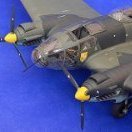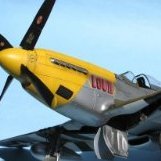Search the Community
Showing results for tags 'hellcat'.
-
So thanks to Tolga and William first of all for piquing my interest in Hellcats after my wife stumbled on one at a a local market, where you can normally buy food, clothes, and whatnot, except model kits. Well, this seller was an exception apparently and for a very modest price (my wife is a great negotiator!) she took it home. Although the kit is a limited edition with 3 Minsi's, it's the same plastic that's probably older than I am. I was intrigued about kitbashing it with a Trumpeter Garfield Hellcat, and so happend to stumble on one at a second hand site here. edit: Williams excellent build is here: And for future reference, as at this moment it's on the same page, but it may not always remain so, here's Tolga's: If there's any other cool Hellcat related thread here, I can always add them of course. So, with a gazillion half-baked projects on the shelf, here I am starting another that will probably end up being half baked as well after I get the main kitbash done, but we'll see about that later. If it helps a bit for other to try it as well... why not? So with both Hellcatkits (speak that aloud a few times!) in hand, i removed the Hasegawa fuselage & Trumpeter lower/upper wing parts from their sprues and started thinking about the easiest way. The Trumpeter kit has wings that mate to the fuselage directly, following it's (bloated) shape, while the Hasegawa as moulded fillets to which the upper wings are glued. The bloated Trumpeter is actually about the size of the fillets wider, so I figured why not cut the Trumpeter upper wing parts straight & be done with it? That seemed, at first, like a workable idea; taped the shape up & if I were to cut along the tape it might work, as evidenced by sliding the part underneath the fillet. Of course things are never that easy, and I was glad (or not!) I tried to fit the lower part as well, before hacking up parts. Remember measure twice, cut once? I discovered 2 insteresting things: the Trumpeter lower wing part, despite the bloated fuselage, is an almost dead-on fit both in curves & length. However, somewhat to my dismay, the at the rear, the Trumpeter wing sits much lower than on the Hasegawa as seen here: Figured there were roughly 2 options (actually 3, leave both models alone & abandon the attempt...) : 1. cut the Hasegawa fillets off (as Willam did on his build as far as I could see), and build up the gap with Evergreen, adapt the upper wing to the Hasegawa fuselage 2. cut the lower wing about 75% off the Trumpeter part, and bend upward to match the Hasegawa fillet. i'm not sure which kit is correct, but looking at the curves & bends of option 2 I went with 1. Of course there'll be someone pointing out the wing will sit too low now... but when I started it my mindset was to make the best of 2 not-so-great kits and live with some shortcuts or inaccuracies. There, I said it So, option 1 it was; I used a Tamiya scriber to carefully get rid of the fillets, some cutting and sawing, until they were off: and, the moment of truth.... as expected, gaps, but I think I these can be closed with Evergreen, and as the Hellcat fuselage had some sort of ridge/fillet where the wings sits, I that may help too. This also needs some adressing with Evergreen: Of course I don't have the required thicknesses of Evergreen, so I'll need a visit to the local shop first before I can attempt to close those gaps up. I've got some other models in the works too, so I might even pause this one until one of those is finished before picking it up again, but hopefully it might help others out with some practical tips & guides. If anyone has some additional tips or info it's welcome as well, after all, I'm just meddling along Another hurdle is that the Trumpeter decals are very inaccurate, but my Hasegawa box has The Minsi, Minsi II and III -historically very significant aircraft, but with wings folded I want something with more markings on the wings, nose and tail -on the Hellcat the fuselage is pretty much invisible. (hence the ? in the title, not sure if I'll do an F6F-3 or F6F-5 yet).
-
Greetings all - and all the best for coming year. Airfix 1/24th Hellcat II NF (F6F-5N), KD127, 892 NAS, Drem, Scotland, mid-1945. Here's my first completion of 2024 which nearly made 2023 but the cold, wet weather was against me for the final varnish coat! The Airfix 1/24th Hellcat is well known and documented so I'll save the background information but suffice to say it's one of the most enjoyable builds I've ever done - it's an absolute beauty of a kit and I loved building it. Whist there are some nice marking options in the box, I decided to go off-piste a little and do something different, hence buying the excellent Aerocraft set (reviewed here) to make this into a Royal Navy night-fighter variant: The level of detail is sublime out of the box, and it went together beautifully with virtually no fit issues whatsoever. What I will say though, is tolerances are very tight indeed and the parts benefit from having their mating surfaces sanded slightly to cater for the thickness of the paint. The gun bays, for example, have a lot of the wing structure to add and thus very careful test-fitting was required to get that satisfying 'click' as it all goes together. The engine is a small model in itself - it took a total of three weeks to get it together and painted. Airfix give you a very detailed construction guide and this enables the builder to add the mass of wiring associated with the ignition harness - I used some aftermarket braided wiring and the effort was well worth it. The surface detailing is some of the best I've ever seen and gives a wonderful 3D effect - when you catch the right light it looks so realistic: Considering this was built OOB with the only additions being the seatbelts (I felt the kit examples were a little over-scaled), the ignition wiring and conversion set, it's exceptional value and quite a presence on the modelling desk. Paints were all Xtracolor enamels and I kept weathering effects to virtually none - these were, in reality, high gloss Dark Sea Blue and pretty clean. The stressed skin effect does most of the work for you to be fair, and other than some light exhaust staining I kept this in line with period photos of late-war Royal Navy Hellcats. To anyone considering building this, a few observations of the build process which may come in useful: As mentioned above, tolerances are very tight - gentle sanding of gluing surfaces and test-fits are a must and it will be very easy for things to become misaligned, especially in the gun bays; If you can, build the engine and main airframe as separate parts and bring them together after painting. I installed the engine as a completed unit prior to the main airframe being painted and this resulted in some very complex masking around the exhausts! The main canopy was quite a bit wider/flared at the base than the runners it is supposed to sit on. I had to coat the inside of the canopy with some Future (to avoid 'fogging') and then attach it with CA glue; The wing tip light lenses are slightly too large for the apertures they sit in - in hindsight I should have test-fitted these earlier in the build and not after painting! Be really careful when following the instructions as to whether you are doing wings folded or extended - the build sequence is very different between the two! Anyway, that's enough waffle from me! All the best, Tom
- 9 replies
-
- aerocraft models
- hellcat
-
(and 2 more)
Tagged with:
-
Hi all After lurking in the shadows, I've eventually got my act together and am starting a post regarding my first build here on LSP . I've built quite a few kits, but this one is going to be my first in the public domain.....I know that there is an "In the Navy" GB going on, but I'm not sure I'll make the deadline for that GB, so didn't post this there. It's going to be a kitbash of the Hasegawa and Trumpeter Hellcats - if it goes that far - but my plan is to use the Hasegawa fuselage mated to the Trumpeter wings, as both kits IMO have their good and bad points. I've got a fair bit of AM to throw at it, and I know there will be some scratch-building required as well.... My overall problem with the Trumpeter kit is the fuselage - it looks way too blown and rounded, it should be more slab-sided, and the Hasegawa fuselage is way better (not perfect) in that respect! I do however like the Trumpy wings more than the Hasegawa offering (sans the Trumpeter mad riveter offering which will have to be addressed), hence foray into a kitbash. If it will turn out that way we'll have to see, I might end up doing a full Hasegawa if it's going to cause to many issues. But I do enjoy a challenge.....(ask my Revell Ju88C-6...it lived - many times it came close to doing a first and final flight into a wall) Here's pictures of the Trumpeter vs Hasegawa fuselages and cowls - you can see how bloated the Trump kit is... Trumpeter left, Hasegawa right. Hasegawa is not perfect, but it's a lot better!! Hasegawa Left, Trumpeter right. The Hasegawa cowl is WAY better than the Trumpeter. Might have to work on the chin and grin a bit, but I'll have a look once I've checked it against my cross-sections and references. So here we go. Hopefully I'll remember to take pictures as I go along If anyone has sage advice, please chip in!! Iain
-
New Year, new model. The beloved bought me the Airfix 1:24 Grumman F6F-5 Hellcat for Christmas and I started it on Boxing Day. Engine just completed and I've saved all the photos up so here they are all in one build post. The P&W 2800 double wasp 10W is a little model all in itself and I think I spent more time researching this than most other models in their entirety. So to business. I'm sure most know that the crankcase of the engine is far to large in diameter to allow the various push rod rings and cylinder blocks to pass over it so lots of flexi file work needed as almost 1mm needs to come off across the diameter. I baulked at paying £9 for a resin one cast from a reduced master, after all this is what modelling's all about. While Airfix seem to have reduced the ejector pin marks, they've made up for it in seam lines so quite a bit of scraping and sanding needed. Once that's done, the cylinders need painting. The bottom halves I did in steel and the top halves in aluminium. I've used Vallejo Metal Colors as I think they're excellent. Quick drying, no mess and no smell and lovely coverage. The push rods were painted gloss black with aluminium ends. The crankcase colour was a first attempt at a mix but it had far too much blue in it. I read it should be Grumman grey but since the engine is made by Pratt & Whitney, not Grumman, I couldn't see that being the case and went for the engine grey specified. I finally settled on a mix of 4:3:1 of Mr Color Aqueous RLM 75 Dark Grey: Tamiya Flat White: Tamiya Blue. It seemed to be not too far away from some of the reference material. You can also see on this photo that I've removed the basic plastic links provided on the parts and replaced them, as they were originally, with rubber hose. The jubilee clips are thin strips of tinfoil. The oil flange is flat black suitably chipped and oil stained. Once everything fits onto the crankcase properly, it's time for the ignition wiring. I used 0.6mm braided cord from Hiroboy along with 1:24 sparkplugs in metal. I was a bit mean to spend a small fortune on scale nuts for the ends of the sparkplugs so I used 1mm evergreen hexagonal rod, drilled and painted silver then sliced into thin slivers and slipped over the end of the sparkplug before the ignition wire was attached. The intake pipes are gunmetal then brushed with copper and duraluminium till I was happy with the effect. The exhaust pipes go on very easily as long as you mark them up when they come off the sprues, otherwise it's a happy half hour mixing and matching. (me? never ) Paintwise, I followed a plan of painting them Tamiya red/brown then airbrushing with a very dilute solution of black/red brown as well as metallics and a light grey around the pipe ends. The heavy wear and chipping on the supercharger intakes is seen on many reference photos and was achieved by spraying first with a coat of duraluminium followed by chipping solution then a top coat of zinc chromate green. It's then a simple task to remove the green layer to the desired effect. Oil effects (which don't show too well on the photos) are sprayed on as a mix of black/redbrown mixed with Alclad Aqua Gloss varnish and diluted with IPA. The oil tank cap is yellow and my eyes were given a great workout by deciding to put the "US 19 Gal" writing on there in individual wet decals Some pics of the engine ready to mount are below, I'll be needing to add a fair bit of non supplied pipework when the time comes but next it's onward and upward to the cockpit. Thanks for looking.
-
Hi Guys Here is a bumper set of new releases all in one go, available for ordering and shipping right now (well over the next few days) Basically a few stand alone decal sheets, to be used in conjunction with the kit decals, early F6F-5 fuselage windows, and a few F6F-5N conversion sets with decals. Before you all ask, yes I am working on the F6F-3 conversion, this will also be done with a few decal sheet options. Release date for the -3 ???????? next few months. Best to visit here to get all the information. https://aerocraftmodels.bigcartel.com/category/1-24th A few pictures for colour (or color for US friends)
-
Hello everyone, the latest kits from the workshop:
-
my last buit , enjoy : voila voila
-
Here is the first of two pilots we are producing for the new 1/24 Hellcat release by Airfix. US Navy/Marine pilot in flying gear. Resin kit Sculpted by Robert Lane Box Art Edward Sage Available from the Elan13 Miniatures website Price: £20.00
- 6 replies
-
- airfix 1/24 th.
- elan13 miniatures
-
(and 1 more)
Tagged with:
-
a very old kit but i like this : [/URL
-
First one in 2018. Trumpeters F6F is like a Garfield - too many lasagnas caused thickness . To hide it i opened canopy. I used: - Montex masks for stars - Eduard Interior - Techmod decals for cat mouth - added cables and other small things. My machine:
-
Our club does an annual 'Group Build' called Build the Same Kit. This year its the Hellcat and mine is the Eduard 1/72 kit. I chose Lt. Stambook, VF-27 from the USS Princeton as my subject (kit decal options) since it had that nice mouth on it (can't really say its a sharks mouth). Already in progress using mostly Vallejo and Model Master paints. This is the Profipack kit, so it has the PE parts for the cockpit (color photoetch). For the first time I was able to get all of the various switches in place and the PE seatbelts. I've seen a few different light blues on these aircraft, but have a feeling the blue I chose is just a LITTLE too bright. Interesting too is that the kill markings are on the right side of the aircraft. Had not seen that before. VF 6 and VF 33 seem to have done this. Working on the washes now, using a light gray around the gun ammo doors (as I've seen in reference photos) and black on the folding wing and flaps. Best as I can tell, the rest of the panels for the most part were not outlined so just leaving them alone. Will hit with a matte finish at the end. Thanks, Chris




.thumb.png.64af68ce3763f9af8a91e71374ce741e.png)


.thumb.jpg.f0920d798d5d8600fb58b1d8a906ddff.jpg)
